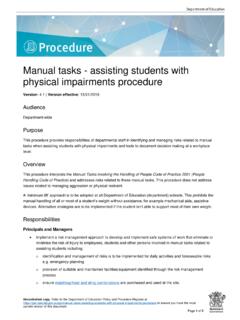Transcription of Recruiting and managing volunteers in the NHS: a practical …
1 Recruiting and managing volunteers in NHS providers a practical guide NHS England September 2017. Recruiting and managing volunteers in NHS providers: a practical guide In this guide 1. The purpose of this guidance 4. 2. Introduction 9. 3. Commitment to volunteering 12. 4. Creating a framework to develop and support volunteering 15. 5. Developing volunteer roles 21. 6. Inclusive approaches to attracting volunteers 25. 7. Recruiting volunteers 29. 8. Safeguarding volunteers , staff and service users 34. 9. induction and training for volunteers 38. 10. Supporting and supervising volunteers 41. 11. Working in partnership 44. 12. Valuing and recognising volunteers ' contributions 49. 13. Appendices 52. Recruiting and managing volunteers in the NHS: a practical guide | page 2. Appendices The case for volunteering in health and care: strategy and policy 53. Plan on a page' volunteer strategy summary 58. Policy and procedures checklist 59. volunteer managers' guide to getting started 60. Example role description 62.
2 Making volunteering inclusive in practice 64. Gifts and goals template 75. Criminal record checks 76. Partnership memorandum of understanding (MOU) 78. managing risk in partnerships 80. Recruiting and managing volunteers in the NHS: a practical guide | page 3. 1. The purpose of this guidance This guidance offers practical support and information The guidance does not deal with every setting or for NHS providers to enable them to support the context in which volunteers are involved in the NHS. strategic ambition to grow and develop volunteering but the key principles can be applied across settings. in the NHS. It will help providers The case studies and examples included aim to develop the right processes, procedures and illustrate how these principles have been put into frameworks to support quality volunteering practice in a range of settings. opportunities that make an impact Approaches can be applied flexibly to ensure achieve a balance in their approach; ensuring recruitment and management is appropriate for the effective processes for recruitment and nature of the volunteer role and the context in which management of volunteers are in place without it takes place.
3 Creating unnecessary barriers or being too risk- This guidance does not focus on wider public averse participation and public voice. Further information on ensure that the approach is accessible and inclusive, this can be found on the NHS England Involvement there are opportunities for a diverse range of Hub. people and volunteers reflect the communities in which we work. This includes involving people who experience the most health inequalities as volunteering can help to reduce these Who is it for? identify existing good practice and develop a framework based on Investing in volunteers , a This guidance is aimed at NHS providers across a range recognised standard for volunteer management of settings including hospitals, primary care, general also recommended by the Lampard Inquiry as practice and community services. a way for NHS trusts to formally review their It will be most useful for those who have a role in volunteering programmes. Recruiting and managing volunteers , particularly voluntary service managers and volunteer coordinators.
4 However, other personnel may also find it useful in their work. Board members and senior Recruiting and managing volunteers in the NHS: a practical guide | page 4. management who have a strategic responsibility We also recognise that a large number of voluntary, for volunteering may find it useful in shaping the community or private sector organisations work in direction of their approach and implementing a partnership with the NHS and involve volunteers in robust framework to support volunteering in their NHS settings. The guidance may also be useful for organisation. these organisations. Brief 1. Examples of volunteer roles in NHS provider organisations Hospitals Buggy service, mobility support Information stand (signposting and Lifestyle coach Discharge assistant Pet therapy guidance) Mentors Hospital guides/navigators Trolley service Expert patients Respite support Welcome volunteers Administrative support Practice health champions Counselling Governors and trustees Running errands and collecting Community settings Advocacy Hospital radio prescriptions/test results/paperwork.
5 Information and advice First responders Ward and department volunteer Chaplaincy Signposting Befriending/buddying/visiting including specialist roles, for Dementia buddies Organising and running activities/. Self-care example Neonatal family support A&E volunteers social organiser/ community volunteers , Intensive Care, Stroke Expert patients Support with unplanned admissions connectors Ward. Dementia friends Outpatient support Teaching and training roles Bedside buddies, befriending, Speech and language support Discharge support Delivering equipment and supplies reading Hospital to Home escorts volunteer mentors supporting other Transport assistance Dining companions, mealtime Health champion volunteers Falls prevention assistance Occupational therapy activity Mobility volunteer /physical activity This list is not comprehensive: it Shop volunteers , tea or caf volunteers volunteers indicates some of the roles undertaken Primary care & general practice Fundraising by volunteers in NHS providers.
6 Library volunteers GP patient participation group Support with long-term conditions volunteers often operate across both Entertainment/music/arts and crafts/ Social and activity event organisers Peer support roles and health settings. activities Interpreters Care champions, Care navigators Recruiting and managing volunteers in the NHS: a practical guide | page 5. Using this guidance This guidance is linked to relevant Investing in volunteers indicators. This guide is interactive. You can: use the contents page to click through to different sections of the guidance. The home' symbol at the bottom of each page returns you to the contents page. use Figure 1 to identify the parts that are most useful to you. Indicators 1-4 are focused on strategic development of volunteering and indicators, 5-9 are focused on practical delivery of volunteering including how to recruit and manage volunteers . The guide does not deal with the indicators in numerical order but instead is organised around the volunteer journey.
7 For example, the guide deals with the setup of your volunteering programme first before moving on to recruitment and management. The diagram links each Investing in volunteers key indicator to the relevant section of the guide. Figure 1: Investing in volunteers , key indicators Recruiting and managing volunteers in the NHS: a practical guide | page 6. of evidence that shows volunteering has a positive Key principles impact on wellbeing and giving is identified as one of the five ways to mental wellbeing and so as an activity in itself, volunteering is of value to the individual and volunteers make a unique contribution the NHS. By giving their time, volunteers make a unique Quality contribution and bring their own credibility to the roles they perform. Involving volunteers provides This guidance is underpinned by tried and tested opportunities for the NHS to learn from the principles of good practice in volunteer management perspectives, insight and experience they bring and to from the Investing in volunteers quality standard.
8 The work in partnership in developing new approaches. standard was recommended by the Lampard Inquiry as a framework for improving the management It is important to recognise that managing volunteers and quality of volunteering and a number of NHS. is different from managing staff. There is no organisations have achieved the standard. This contractual relationship between volunteers and principle recognises that offering and delivering the organisation. Instead the relationship is based quality volunteering experiences is vital to volunteer on mutually agreed expectations about the role. retention and ensuring that people want to continue volunteers have different roles from staff (and should to give their time. It is also about ensuring the right not replace staff) and have different motivations and structures and support are in place so volunteers can expectations. These are key underpinning principles to have a positive impact and make a difference. understand in order to recruit and manage volunteers well.
9 Flexibility Volunteering should be mutually beneficial We recognise the enormous scope and scale of volunteering in the NHS and more broadly in health Volunteering should have a positive impact that and care. This guidance encourages the flexibility makes a difference to patients, staff and the work needed to accommodate the range of volunteer roles of the NHS but volunteers should get something in NHS provider organisations and the contexts in out of the experience too. This may include making which they are engaged. a difference to a cause they care about or meeting people and feeling part of the community. volunteers may value the opportunity to develop new skills and gain experience. There is also a growing body Recruiting and managing volunteers in the NHS: a practical guide | page 7. Inclusivity This guidance aims to help NHS providers take an inclusive approach to volunteering and develop accessible opportunities. By ensuring volunteering is accessible it can help a diverse range of people get involved and promote equality, improve reach into communities and reduce health inequalities.
10 Collaboration and a culture of partnership This guidance encourages day-to-day collaboration between volunteers and staff. It recognises volunteers as part of the wider NHS family and the value of their contribution alongside paid professionals. It aims to support an asset-based approach and culture of partnership. Asset-based approaches are place-based approaches that develop local solutions, drawing on all the assets and resources of an area; integrating public services and also building the resilience of communities. It also provides support to organisations who are already working in partnership with NHS. providers to effectively recruit and manage volunteers . Recruiting and managing volunteers in the NHS: a practical guide | page 8. 2. Introduction An estimated three million people volunteer in health Brief 2. Volunteering makes a difference and care. The time volunteers give every day, in a very wide range of roles, makes a valuable contribution to To people, patients and service users the quality of care that patients experience.














